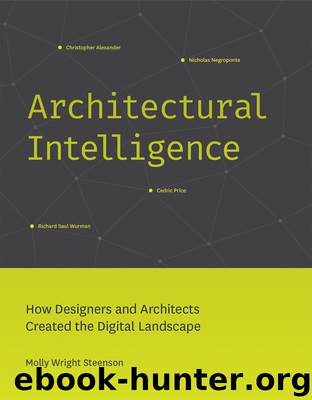Architectural Intelligence by Molly Wright Steenson

Author:Molly Wright Steenson
Language: eng
Format: epub
Tags: computer human interaction; HCI; AI; information architecture; computer science; systems; media; technology; design; Christopher Alexander; Richard Saul Warren; Cedric Price; Nicholas Negroponte; history; digital
Publisher: The MIT Press
5 Cedric Price: Responsive Architecture and Intelligent Buildings
“Technology is the answer, but what was the question?” asked British architect Cedric Price (1934–2003) in a lecture he gave by that title in London in January 1979—a question that is one of the best lenses for both understanding his work and framing its relevance. The iconoclastic architect argued that the point of architecture should not be to lock people down, but rather to open them up: “to ease up the choice, to free the opportunities of the individual user as to what they would do next,” he told his audience.1 How might architectural projects “generate new thoughts” in the minds of the people who interact with them?2 How might architecture and technology work together, not for clarity and usability, but for some different purpose that the architect or technologist didn’t predetermine? “I feel that the real definition of architecture is that which through a natural distortion of time, place, and interval creates beneficial social conditions that hitherto were considered impossible,” Price said.3 He concluded the lecture saying that “it’s worth mentioning that with the advent of the microprocessor and the silicon chip more and more people are going to be in the situation where they themselves, have to decide what to do. Society, economic circumstances, will make no demands on their time, but they’ll live just as long, unless they kill themselves through boredom.”4
Price’s projects, most of which weren’t built, embodied the characteristics of technological and computational paradigms. The proposed Fun Palace collaboration (1963–1967) with radical theater director Joan Littlewood applied cybernetics at an architectural scale, in a building that would have learned from, responded to, and adapted with its users. The five-story multimedia Oxford Corner House (1965–1966, unbuilt), with movable floors, was an information environment with screens everywhere that were to project news and educational content. And the Generator project (1976–1979, unbuilt), a set of mobile twelve-foot cubes and walkways movable by crane, was designed to be recombined however its users wanted. Each element was to be fitted with a microcontroller and governed by a suite of computer programs. If its parts weren’t moved around enough, Generator would get bored and redesign itself. These projects were decades ahead of their time and would still be radical if they were built today. Information architects and contemporary digital designers outside architecture probably are not familiar with his work. Yet his playfulness and his provocations make me wonder whether Price might be the secret patron saint of interaction designers and information architects.
Although Price’s built projects weren’t quite as revolutionary as the sketches and plans for some of his unbuilt work, they still were remarkable. The Snowdon Aviary at the London Zoo, designed with his friend and engineering collaborator Frank Newby, and Lord Snowdon, in 1961, features an aluminum tensegrity frame that pulls back large triangles, over which a mesh is stretched. As architect Will Alsop, who worked for Price in his early career, wrote, “It was designed for a community of birds and the idea was that once the community was established, it would be possible to remove the netting.
Download
This site does not store any files on its server. We only index and link to content provided by other sites. Please contact the content providers to delete copyright contents if any and email us, we'll remove relevant links or contents immediately.
| Computer Vision & Pattern Recognition | Expert Systems |
| Intelligence & Semantics | Machine Theory |
| Natural Language Processing | Neural Networks |
Algorithms of the Intelligent Web by Haralambos Marmanis;Dmitry Babenko(16234)
Jquery UI in Action : Master the concepts Of Jquery UI: A Step By Step Approach by ANMOL GOYAL(9386)
Test-Driven Development with Java by Alan Mellor(7730)
Data Augmentation with Python by Duc Haba(7608)
Principles of Data Fabric by Sonia Mezzetta(7378)
Learn Blender Simulations the Right Way by Stephen Pearson(7294)
Microservices with Spring Boot 3 and Spring Cloud by Magnus Larsson(7137)
Hadoop in Practice by Alex Holmes(6587)
RPA Solution Architect's Handbook by Sachin Sahgal(6515)
The Infinite Retina by Robert Scoble Irena Cronin(6215)
Big Data Analysis with Python by Ivan Marin(5931)
Life 3.0: Being Human in the Age of Artificial Intelligence by Tegmark Max(5509)
Pretrain Vision and Large Language Models in Python by Emily Webber(4894)
Infrastructure as Code for Beginners by Russ McKendrick(4652)
Functional Programming in JavaScript by Mantyla Dan(4436)
WordPress Plugin Development Cookbook by Yannick Lefebvre(4381)
The Age of Surveillance Capitalism by Shoshana Zuboff(4243)
Embracing Microservices Design by Ovais Mehboob Ahmed Khan Nabil Siddiqui and Timothy Oleson(4146)
Applied Machine Learning for Healthcare and Life Sciences Using AWS by Ujjwal Ratan(4135)
